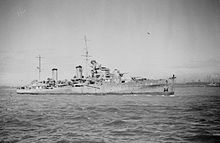HMS Gurkha (F20)
|
||||||||||||||||||||||
|
||||||||||||||||||||||
|
||||||||||||||||||||||
|
||||||||||||||||||||||
HMS Gurkha ( ship identification : F20, L20) was a (second) tribal class destroyer of the British Royal Navy . The Gurkha was lost on April 9, 1940 by a bomb hit off Norway. She was the class’s first war loss in World War II.
History of the ship
On March 10, 1936, the Fairfield Shipbuilding and Engineering yard in Govan near Glasgow received an order to build a destroyer of the new Tribal class, the keel of which was laid on July 6, 1936. The launch of the HMS Gurkha took place on July 7, 1937. She was the third ship of the Royal Navy named after the Nepalese Gurkha tribe after a torpedo boat and a destroyer of the first tribal class , which was written differently HMS Ghurka . On October 21, 1938, the HMS Gurkha was part of the “1st. Tribal destroyer flotilla ”, the later 4th destroyer flotilla, put into service. In November 1938, after completing all tests and completing the equipment, the destroyer moved to its unit in the Mediterranean fleet in Malta .
Mission history
Until the outbreak of the Second World War , the ship completed training trips and visits to ports in the Mediterranean . Due to a collision with the Sikh , she was out of action for almost seven weeks in March / April 1938.
In September 1939 she took over the supervision of the activities of the Italian Navy in the Red Sea with the sister ships Sikh , Mohawk and Afridi . In October the Gurkha was ordered back to the Home Fleet with the 4th Destroyer Flotilla , but failed from late November 1939 to early February 1940 due to damage to the turbine blades and the feed water supply typical for the class.
Back in service with the Home Fleet, she sank the German submarine U 53 west of the Orkney Islands on February 23, 1940 at the position ♁60 ° 32 ′ N, 6 ° 14 ′ W by depth charges.
On April 8, four cruisers of the 1st cruiser squadron set off from Rosyth after unloading troops already embarked, accompanied by the Gurkha and the sister ships Afridi , Sikh , Mohawk , Zulu and Cossack to repel the German attack on Norway .
The end of the Gurkha
On April 9, 1940, the British formed an attack formation against Bergen with the cruisers Manchester , Southampton , Sheffield and Glasgow and the destroyers Afridi , Gurkha , Sikh , Mohawk , Somali , Matabele and Mashona as well as the cruiser Aurora . The formation fell apart a little because the destroyers could not follow the speed of the cruisers in the prevailing weather conditions. The Luftwaffe attacked this attack unit and the main unit of the Home Fleet with Ju-88 and He-111 bombers from Kampfgeschwader 30 and 26 respectively . In an attempt to create a better field of fire, the Gurkha left the protection of the flotilla and was badly hit early on. Their failure was only noticed when the attack on Bergen was canceled.
The cruiser Aurora was the only one who had heard the Gurkha's distress calls , reached the sinking destroyer before it sank and took over most of the crew with its boats. In addition, a number of castaways could still be rescued from the sea, so that a total of 194 men were rescued from the Aurora . The Gurkha fell on the evening of April 9, 1940 southwest of Bergen in position 59 ° 13 '0 " N , 4 ° 0' 0" O . She was the first British destroyer to be sunk in an air raid. Their crew was rescued up to 16 men, as the Mashona searching the place of the sinking was able to rescue five castaways.
literature
- David Lyon: HMS Cossack Tribal Class Destroyer. Profile Publication Ltd., Windsor 1970.
- David Lyon: The British Tribals, 1935 in Superdestroyers. Conway Maritime Press, Greenwich 1978, ISBN 0-85177-131-9 .
- Jürgen Rohwer , Gerhard Hümmelchen : Chronicle of the naval war 1939-1945. Manfred Pawlak, Herrsching 1968, ISBN 3-88199-0097 .
- MJ Whitley: Destroyer in World War II. Motorbuch Verlag, Stuttgart 1991, ISBN 3-613-01426-2 .
Web links
- Geoffrey B Mason: Service history HMS GURKHA (L 20) - Tribal-class Destroyer
- Don Kindell: HMS GURKHA - Bombing attack of 9th April 1940 and reports on sinking
- "TRIBAL" destroyers (1938-1948)

